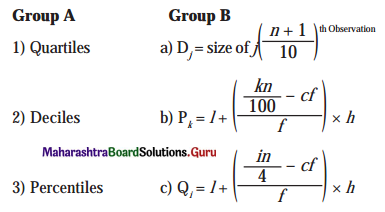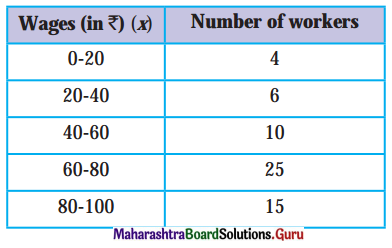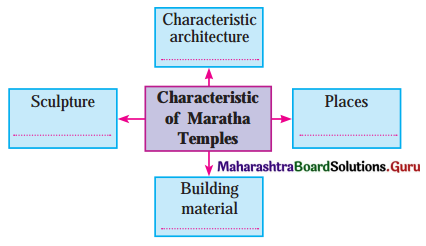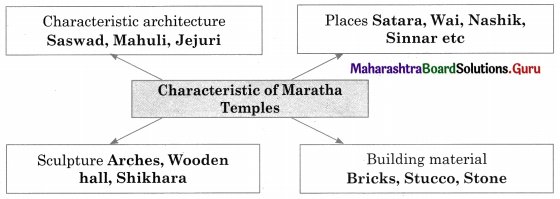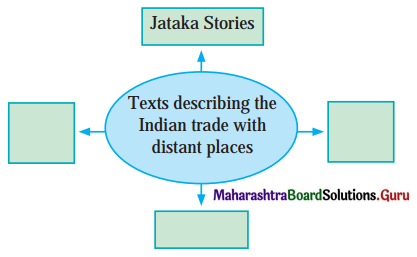Std 11 Economics Chapter 4 Question Answer The Economy of Maharashtra Maharashtra Board
Balbharti Maharashtra State Board Class 11 Economics Solutions Chapter 4 The Economy of Maharashtra Textbook Exercise Questions and Answers.
Class 11 Economics Chapter 4 The Economy of Maharashtra Question Answer Maharashtra Board
Economics Class 11 Chapter 4 Question Answer Maharashtra Board
1. Give economic terms:
Question 1.
Investments did by foreign companies in our country.
Answer:
Liberalisation
Question 2.
Programme for development of the small, medium, and micro industries.
Answer:
MSICDP
![]()
Question 3.
The basic requirement for facilitating the production and distribution of goods and services for economic development.
Answer:
Social infrastructure
Question 4.
A movement that promotes values of self-help democracy and equality.
Answer:
Co-operative movement
2. Find the odd word out:
Question 1.
Agricultural Indebtedness, dry farming, lack of capital, engineering
Answer:
Engineering
Question 2.
Tourism, Banking, Automobile Production, Insurance
Answer:
Automobile Production
Question 3.
Pune, Hyderabad, Nasik, Nagpur
Answer:
Hyderabad
![]()
Question 4.
MTDC, MAITRI, SEZ, MIDC
Answer:
MTDC
Question 5.
Primary education, Hospitality, Higher education, Skill-based education.
Answer:
Hospitality
3. Identify and explain the concepts from the given illustrations:
Question 1.
To facilitate research in robotic technology, Japan has invested ₹ 1000 crores in India.
Answer:
Liberalisation – Foreign Direct Investment (FDI).
Due to the Liberalisation Act of 1991, foreign direct investment became easy in the Indian Industrial Sector. This led Japan to invest ₹ 1000 crores in India.
The FDI inflow in Maharashtra till September 2017 was ₹ 6,11,760 crores.
Question 2.
Prajakta and her family visited the beaches during her eight-day Diwali vacation.
Answer:
Tourism.
It is a business of providing and arranging holidays and the tourism department focuses to attract more and more tourists to Maharashtra to earn revenue for the state. To promote tourism, the government formulated Maharashtra Tourism Policy, 2016.
Question 3.
Pravin from Latur works as a technician in the films division at Mumbai city.
Answer:
Entertainment Industry.
The Entertainment Sector of Maharashtra generates employment opportunities for a large number of people. Thus, Pravin came to Mumbai and worked as a technician in the film division.
Question 4.
Rani Gond from Chandrapur works as a hostess with the Mumbai-Goa cruise ship.
Answer:
Hospitality.
It means friendly and generous receptions and entertainment of guests, visitors, or strangers. Hospitality is a broader industry than other industries and has grown rapidly in Maharashtra due to the development of the tourism business in Maharashtra.
![]()
4. Distinguish between:
Question 1.
Economic Infrastructure and Social Infrastructure.
Answer:
| Economic Infrastructure | Social Infrastructure |
| (i) Economic Infrastructure is the basic facilities of production and distribution of goods and services for economic development. | (i) Social infrastructure is the basic facilities to improve the quality of human life. |
| (ii) It includes telecommunication, electricity, transportation, energy, etc. | (ii) It includes health, education, and housing. |
Question 2.
The agriculture sector and Service sector.
Answer:
| Agricultural Sector | Service Sector |
| (i) Agricultural sector is known as the primary sector. It includes the production of raw materials and basic foods. | (i) The service sector is known as the tertiary sector. They mainly provide services to the general population and to the business. |
| (ii) E.g. farming, fishing, hunting, mining, etc. | (ii) E.g. restaurants, tourism, banking, insurance, etc. |
Question 3.
Tourism and Hospitality.
Answer:
| Tourism | Hospitality |
| (i) Tourism refers to the business of providing and arranging holidays and services to the people who are visiting a place. | (i) Hospitality refers to the relationship between a guest and host, wherein the host receives the guest with goodwill. |
| (ii) It includes activities such as sightseeing and camping. | (ii) It includes reception, entertainment of guests, visitors, etc. |
Question 4.
Education and Health Services.
Answer:
| Education | Health Services |
| (i) Education is about teaching, learning skills, and knowledge. It also means helping people to learn and think about what they learn. | (i) Health services refer to medical professionals, organizations, and ancillary health care workers who provide medical care to those in need. |
| (ii) Education refers to a profession where people are educated for their personal development. | (ii) Health refers to mental health, physical health, etc. |
5. Answer the following:
Question 1.
Explain the role of Co-operative movement in Maharashtra.
Answer:
Following is the role of the Co-operative movement in Maharashtra:
- Co-operative movements have been vastly successful in the overall improvement of the quality of life in rural areas.
- The co-operative movement has improved the lives of the people and has made a significant contribution to the economy of Maharashtra.
- Due to cooperative movement, Maharashtra is considered as the land of opportunities, as it is one of the most developed states, not only economical but also in terms of infrastructure.
- There are some other roles of co-operative movements such as agro-processing industry, agro-marketing, sugar co-operatives, fisheries Co-operative societies, Co-operative dairy societies, textiles, housing societies, etc.
![]()
Question 2.
Explain in detail the measures taken by the government for the agricultural development of Maharashtra.
Answer:
Following are the measures are taken by the government for the agriculture development of Maharashtra:
- Availability and distribution of quality seeds, fertilizers, pesticides, water sources by dams, well, turbines, etc.
- Establishment of Centre of Excellence to transfer technologies, creating awareness about agricultural information.
- Use of renewable energy in agriculture and allied activities.
- Creation of water resources for round the year cultivation.
- The Pradhan Mantri Krishi Sinchai Yojana(PMKSY) is another scheme to expand the cultivated areas with assured irrigation and reduce wastage of water.
- National Agriculture Market (NAM) has been introduced to promote reform of the agricultural marketing sector.
Question 3.
Explain the major problems in the industrial sector of Maharashtra.
Answer:
Major problems in the industrial sector are as follows:
- On the government level, the decision-making system is so poor that it results in huge cost escalation, increasing interest burden, and higher burden on consumers.
- India’s population is very high but there is a shortage of trained, well-educated, energetic, and experienced people.
- The technology used in industries is outdated and it affects production.
- Lack of infrastructures like transportation, communication, sewage, water, and electric system available at a high cost, results in an increase in production cost.
- Due to a lack of motivation for new entrepreneurs, self-motivation will help to achieve the entrepreneurial goals.
- Regional imbalances exist in all sectors of the economy. Especially, it is found more in the industrial sector.
Question 4.
Explain the measures taken to develop social infrastructure in Maharashtra.
Answer:
Measures taken to develop social infrastructure in Maharashtra are as follows:
(i) Education:
- Right to Education (RTE) to children in the age group of 6-14 years.
- Free and compulsory education under the program Sarva Shiksha Abhiyan (SSA).
- Rashtriya Madhyamik Shiksha Abhiyan (RMSA) was launched in 2009 to improve access and quality secondary education.
- Efforts are taken to expand opportunities in higher education.
- Other measures like inclusive education, girl’s education, adult literacy, and tribal education were also taken by the government.
(ii) Health Services:
Various programmes like National Rural Health Mission (NRHM) and National Urban Health Mission – (NUHM) were undertaken to strengthen the health system in rural and urban areas created 3 tier health infrastructure to provide comprehensive health services.
(iii) Tourism:
- Formulated Maharashtra Tourism Policy, 2016.
- Organises different events like the Ellora festival, Elephanta festival, etc.
- Launched the scheme of ‘Mahabhraman’.
(iv) Hospitality:
Provides services through, Airlines, Mumbai-Goa cruise ships, fancier trains (Deccan Odyssey), restaurants, etc.
![]()
(v) Entertainment:
Generated employment opportunities by producing a large number of films.
6. Read the following passage and answer the questions given below:
The government of India has launched an ambitious programme of ‘Bharatnet’ for rural India by keeping in mind today’s modern era. More than one lakh rural (Grampanchayat) areas have been connected under Bharatnet’s high-speed broadband scheme. Maharashtra has become the best-performing state. East Uttar Pradesh, Chattisgarh, Rajasthan, and Jharkhand have also been placed among the best performing states in the first phase of the Bharatnet broadband connection scheme.
Question 1.
Why did the Government of India launch the Bharatnet project?
Answer:
The Government of India launched the ambitious programme of Bharatnet especially for rural India to get connected under Bharatnet’s high-speed broadband scheme.
Question 2.
How many Gram panchayats have received Internet services?
Answer:
More than one lakh Gram panchayats have received internet services.
Question 3.
Which states have been placed as the best performing states in the first phase of Bharatnet?
Answer:
Maharashtra, East Uttar Pradesh, Chattisgarh, Rajasthan, and Jharkhand have been placed as the best-performing state in the first phase of Bharatnet.
Question 4.
‘Internet has brought the world closer’ – Express your views on it.
Answer:
Yes, Communication has become very simple through e-mails. People can get connected online through the internet which can see each other living in another corner of the world. Through the internet, we can get each and every piece of information required for studies, research, business, etc. Messaging apps are the fastest way of communication that can be connected through the internet which also saves cost.
11th Economics Digest Chapter 4 The Economy of Maharashtra Intext Questions and Answers
Find out: (Textbook Page No. 26)
Names of any five enterprises from each category producing the following goods in Maharashtra: chemicals, food processing, textiles, automobiles, I.T., and pharmaceuticals.
Answer:
Companies or Enterprises producing the following goods in Maharashtra:
| Chemical | Food Processing | Textiles | Automobiles | I.T. | Pharmaceutical |
| 1. Core Chemical Mumbai Pvt. Ltd. (Mumbai) | 1. Malpani Food Industries (Pune) | 1. Tuni Textile Mills Ltd. Mumbai) | 1. Force Motors (Pune) | 1. Computer World (Pune) | 1. Aarey Drugs and Pharmaceuticals Pvt. Ltd. (Boisar) |
| 2. Dai Ichi Karkaria Ltd. (Mumbai) | 2. Protein Food Industries (Hadapsar, Pune) | 2. Bafna Textile Mumbai) | 2. Maruti Udyog Ltd. Mumbai) | 2. Wizertech Informatics Pvt. Ltd. Mumbai) | 2. Aditya Air Products Pvt. Ltd. (Nagpur) |
| 3. Molychem (Mumbai) | 3. Vista Processed Foods Pvt. Ltd. (Navi Mumbai) | 3. Baba Weaving Mills (Solapur) | 3. Volvo India Pvt. Ltd Mumbai) | 3. Marvell India Pvt. Ltd. (Pune) | 3. Allwin Medical Pvt. Ltd. (Raigad) |
| 4. Hindustan Organic Chemical (Rasayani) | 4. Forstal Frozen Foods Pvt Ltd. (Navi Mumbai) | 4. Aruna Fabrics (Kolhapur) | 4. DSK Toyota DSK Motors Ltd. (Pune) | 4. Ideal Computer and Softwares (Mumbai) | 4. Ambica Diagnostics (Aurangabad) |
| 5. Sanika Chemicals Pvt Ltd (Mahad) | 5. Tastel Fine Food Pvt Ltd. (Mumbai) | 5. Navjeevan Mills Pvt Ltd. Mumbai) | 5. Arihant Auto Industries (Nashik) | 5. Lotus Info System (Mumbai) | 5. Cellulose Pharma Chem (Nashik) |
[Source: Internet]
![]()
Try this: (Textbook Page No. 27)
Classify the services into services for business and services for final consumers.
[Fintech, IT/ITES, Startups, Cloud Computing, Electric Vehicles, Defence, Tourism and Private Universities]
Answer:
| Services for Business | Services for Final Consumers |
| 1. Fintech | (a) Electric Vehicles |
| 2. IT/ITES | (b) Defence |
| 3. Startups | (c) Tourism |
| 4. Cloud Computing | (d) Private Universities |
| 5. Defence |
Think about it: (Textbook Page No. 25)
What will happen if the farmers sell their farm produce without the middlemen?
Answer:
- Middleman charge commission and make a profit by taking goods from farmers and selling them to the general public.
- If the middleman is removed then farmers will get more price for their produce as well as consumers will also get products at a lesser price.
- Sometimes middlemen create an artificial shortage of products which increases the price, thus this artificial shortage can be cut down by abolishing middlemen.
- Farmer can get right to fix price for their own product after adding sufficient profit margin which will help them to grow in future.
Find out: (Textbook Page No. 28)
Symbols of the following:
(i) Sarva Shiksha Abhiyan (SSA)
(ii) Rashtriya Madhyamik Shiksha Abhiyan (RMSA)
(iii) Adult Literacy Mission (ALM)
Answer:
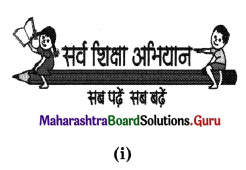
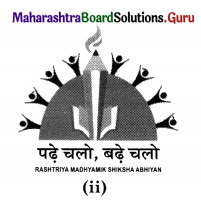
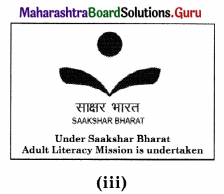
Maharashtra State Board Class 11 Economics Textbook Solutions
- Basic Concepts in Economics Class 11 Economics Textbook Solutions
- Money Class 11 Economics Textbook Solutions
- Partition Values Class 11 Economics Textbook Solutions
- The Economy of Maharashtra Class 11 Economics Textbook Solutions
- Rural Development in India Class 11 Economics Textbook Solutions
- Population in India Class 11 Economics Textbook Solutions
- Unemployment in India Class 11 Economics Textbook Solutions
- Poverty in India Class 11 Economics Textbook Solutions
- Economic Policy of India Since 1991 Class 11 Economics Textbook Solutions
- Economic Planning in India Class 11 Economics Textbook Solutions
